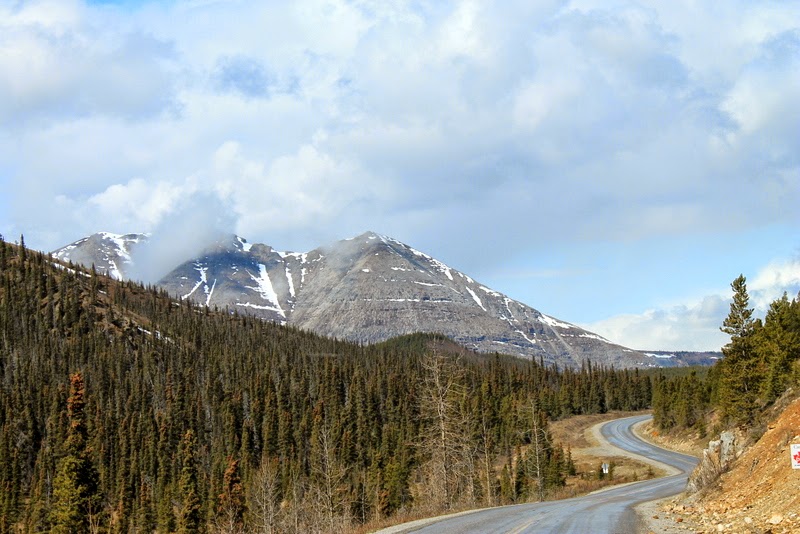It was only 130 miles from Liard River to Watson Lake. We can now add the Yukon to our travel map. We have been in 11 of Canada's 13 provinces since going on the road. The drive offered more great scenic vistas and more wildlife. There was a bit more traffic, but not really what I would call busy. A couple of times I could see one vehicle ahead and one in the mirror. It may be heavier after we leave Watson Lake as the Cassiar Highway meets the Alaska here. We spent two days in Watson Lake, which apparently is not the norm because we were the only people in the campground by 10 AM. By 5:00 in the afternoon there were about 25 rigs.
We have stayed in Campgrounds every night mainly to be able to plug in for power rather than running the generator during the cool mornings. While the campgrounds have been very expensive we have had wifi at all but one, so I have been able to keep up to date with the world, not that it really matters. It does let me keep up with the blog so when the wifi is good I try to get a couple written. At the Downtown RV Park in Watson Lake the connection was great yesterday when no one was there, but I could not get connected either evening when the place is packed. At most of our other stops the connection has been good and unlimited.
We had not gone five miles up the road from Liard River when we began seeing the wood bison. Some were on the road, some in the grass and a few in the trees. Bison are the largest mammals in North America and, while they appear to be calm and gentle while grazing, they are wild animals that can be very dangerous. A big problem here is people hitting them while driving at night. I can't imagine how much damage that would do.
And of course more bears. We stopped and this one gave us a good look before going back to eating.
I'm not sure, but this may be our first grizzly. It was small and did not have that characteristic hump, but it was brown. We have seen so many bears we have lost count. We don't even slow down for a picture of every one and this is only our third day on the Alaska Highway.
Typical of the days drive through Northern BC. Rolling hills and a lot of trees.
Most of the day we traveled along the Liard River. After spending the winter in the arid Southwest it has been wonderful seeing all the trees and so much water. All of the aspen leaves are out and the green is beautiful. Spring is further along here than it was on the plains in Alberta where the leaves were not out.
A typical crowded rest area. This one even a had a toilet while most are just wide spots in the road with a trash can.
Blue sky, trees and blue water.
More mountains come into view. They do a good job of keeping a wide area cleared on both sides of the road, which gives you a chance to slow down when you spot wildlife.
Watson Lake Motors was built of logs in 1953 to start serving travelers on the Alaska Highway after the ban on civilian travel was lifted. It must have been some trip in the 1950's. It was the largest repair shop north of Fort St. John a few hundred miles.
Watson Lake is famous for the Sign Forest that was started in 1942 when a soldier added his hometown to a signpost with the names of distant cities like New York, Pittsburgh, Chicago and Tokyo. A tradition was started that continues to this day.
A few signs of places we know very well. The Brooke High is for all our West Virigina family and friends who attended school there. The others are Western PA towns near where we had our stix and brix.
We even found the sign that Mark and Renita put up for Betty two years ago. We had planned to hang it but when our plans changed they did the job. We sure do miss that place and Betty.
The latest total is over 78,000 and growing. There are signs from around the world. Makes me wonder how many of them were stolen as a great number of them are official road signs.
They even have some old highway equipment that worked on the road.
We are now forever immortalized in Watson Lake with our very own homemade, not stolen, Washington PA sign.
It is in the center on the outside row so if you are passing through Watson Lake see if you can find it.
What is a trip to the Yukon without seeing the Northern Lights. They are just fantastic. Actually, they are not seen in the summer because there is to much daylight. We do recommend going to the local planetarium, the Northern Lights Center, for a great look at this beautiful phenomenon. It will be much warmer than coming to see them in the winter.
Another new bird for us, a green winged teal. We saw it on our walk on the nature path around Wye Lake. Watson Lake is a must stop if you are driving the Alaska Highway. Don't be like the couple we saw who just slowed down and took a picture from the car. It is neat searching through the sign forest.























































